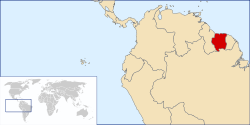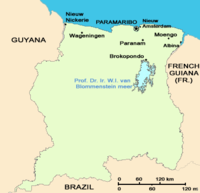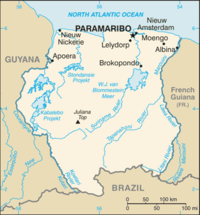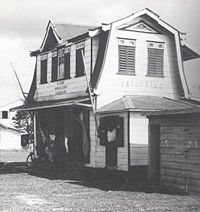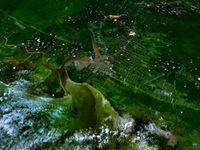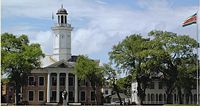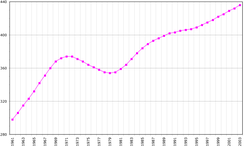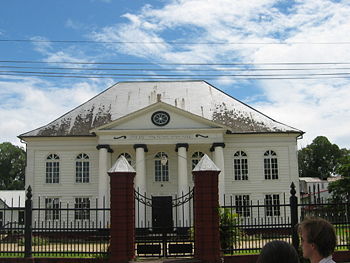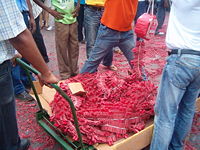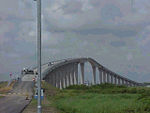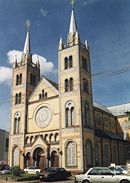Suriname
2008/9 Schools Wikipedia Selection. Related subjects: Americas; Countries
| Republiek Suriname Republic of Suriname
|
||||||
|---|---|---|---|---|---|---|
|
||||||
| Motto: Justitia - Pietas - Fides (Latin) "Justice - Duty - Loyalty" |
||||||
| Anthem: God zij met ons Suriname (Dutch) ('God be with us Suriname') |
||||||
|
|
||||||
| Capital (and largest city) |
Paramaribo |
|||||
| Official languages | Dutch | |||||
| Recognised regional languages | Sranan Tongo, Hindi, English, Hindustani, Javanese, Marathi, Bhojpuri, Hakka, Cantonese, Boni, Saramaccan, Paramakan, Ndyuka, Kwinti, Matawai, Cariban, Arawakan, Aluku, Kalina | |||||
| Demonym | Surinamese | |||||
| Government | Constitutional democracy | |||||
| - | President | Ronald Venetiaan | ||||
| Independence | From the Netherlands | |||||
| - | Date | November 25, 1975 | ||||
| Area | ||||||
| - | Total | 163,821 km² ( 91st) 63,251 sq mi |
||||
| - | Water (%) | 1.1 | ||||
| Population | ||||||
| - | July 2005 estimate | 470,784 ( 170th) | ||||
| - | 2004 census | 487,024 | ||||
| - | Density | 2.7/km² ( 223rd) 7.0/sq mi |
||||
| GDP ( PPP) | 2005 estimate | |||||
| - | Total | $2.898 billion ( 160st) | ||||
| - | Per capita | $5,683 ( 96th) | ||||
| HDI (2007) | ▲ 0.774 (medium) ( 85th) | |||||
| Currency | Surinamese dollar ( SRD) |
|||||
| Time zone | ART ( UTC-3) | |||||
| - | Summer ( DST) | not observed ( UTC-3) | ||||
| Internet TLD | .sr | |||||
| Calling code | +597 | |||||
Suriname (Dutch: Suriname; Sranan Tongo: Sranan), officially the Republic of Suriname (traditionally spelled Surinam by the English who founded the first colony at Marshall's Creek, along the Suriname River, but the Dutch spelling is more widely accepted), is a country in northern South America.
Suriname was formerly known as Nederlands Guyana, Netherlands Guiana or Dutch Guiana. Suriname is situated between French Guiana to the east and Guyana to the west. The southern border is shared with Brazil and the northern border is the Atlantic coast. The southernmost border with French Guiana is disputed along the Marowijne river; while the once-disputed boundary with Guyana was arbitrated by the United Nations Convention on Law of the Sea on September 20, 2007. The country is the smallest sovereign state in terms of area and population in South America.
History
European exploration of the area began in the 16th century by Dutch, French, Spanish and English explorers. In the 17th century, plantation colonies were established by the Dutch and English along the many rivers in the fertile Guyana plains. The earliest documented colony in Guiana was by an Englishman named Marshall called Marshall's Creek, along the Suriname River. At the Treaty of Breda, in 1667, the Dutch decided to keep the nascent plantation colony of Suriname conquered from the British, while leaving the small trading post of New Amsterdam in North America, now New York City, in the hands of the British.
The Dutch planters relied heavily on African slaves to cultivate the coffee, cocoa, sugar cane and cotton plantations along the rivers. Treatment of the slaves by their owners was notoriously bad, and many slaves escaped the plantations. With the help of the native South Americans living in the adjoining rain forests, these runaway slaves established a new and unique culture that was highly successful in its own right. Known collectively in English as the Maroons, and in Dutch as "Bosnegers," (literally meaning "Bush negroes"), they actually established several independent tribes, among them the Saramaka, the Paramaka, the Ndyuka or Aukan, the Kwinti, the Aluku or Boni and the Matawai.
The Maroons would often raid the plantations to recruit new members, acquire women, weapons, food and supplies. These attacks were often deadly for the planters and their families, and after several unsuccessful campaigns against the Maroons, the European authorities signed several peace treaties with them in the 19th century, granting the Maroons sovereign status and trade rights.
Slavery was abolished by the Netherlands in Suriname in 1863, but the slaves in Suriname were not fully released until 1873, after a mandatory 10 year transition period during which time they were required to work on the plantations for minimal pay and without state sanctioned torture. As soon as they became truly free, the slaves largely abandoned the plantations where they had suffered for several generations, in favour of the city, Paramaribo. As a plantation colony, Suriname was still heavily dependent on manual labor, and to make up for the shortfall, the Dutch brought in contract laborers from the Dutch East Indies (modern Indonesia) and India (through an arrangement with the British). In addition, during the late 19th and early 20th centuries, small numbers of mostly men were brought in from China and the Middle East. Although Suriname's population remains relatively small, because of this history it is one of the most ethnically and culturally diverse in the world.
In 1954, the Dutch placed Suriname under a system of limited self-government, with the Netherlands retaining control of defense and foreign affairs. In 1973, the local government, led by the NPK (a largely Creole, meaning ethnically African or mixed African-European, party) started negotiations with the Dutch government leading towards full independence, which was granted on 25 November 1975. The severance package was very substantial, and a large part of Suriname's economy for the first decade following independence was fueled by foreign aid provided by the Dutch government.
The first President of the country was Johan Ferrier, the former governor, with Henck Arron (leader of the Suriname National Party) as Prime Minister. Nearly one third of the population of Suriname at that time emigrated to the Netherlands in the years leading up to independence, as many people feared that the new country would fare worse under independence than it did as an overseas colony of the Netherlands. Suriname's diaspora therefore includes more than a quarter of one million people of Suriname origin living in the Netherlands today, including several recent members of the Dutch national football (soccer) team.
On February 25, 1980, a military coup sidelined the democratic government, and with it began a period of economic and social hardship for the country. On 8 December 1982, the military, then under the leadership of Desi Bouterse, rounded up several prominent citizens who were accused of plotting against the government. They were allegedly tortured and certainly killed during the night, and the Netherlands quickly suspended all foreign aid to Suriname after this event. (Desi Bouterse is scheduled to stand trial in Suriname in the fall of 2007 for his role in these killings.)
Elections were held in 1987 and a new constitution was adopted, which among other things allowed the dictator to remain in charge of the army. Dissatisfied with the government, Bouterse summarily dismissed them in 1990, by telephone. This event became popularly known as "the telephone coup". Bouterse's power began to wane after the 1991 elections however, and a brutal civil war between the Suriname army and the Maroons, loyal to the rebel leader Ronnie Brunswijk, further weakened his position during the 1990s.
Suriname's democracy gained some strength after the turbulent 1990s, and its economy became more diversified and less dependent on Dutch financial assistance. Bauxite (Aluminium ore) mining continues to be a strong revenue source, but the discovery and exploitation of oil and gold has added substantially to Suriname's economic independence. Agriculture, especially of rice and bananas, remains a strong component of the economy, and ecotourism is providing new economic opportunities. More than 80% of Suriname's land-mass consists of unspoiled rain forest, and with the establishment of the Central Suriname Nature Reserve in 1998, Suriname signaled its commitment to conservation of this precious resource. The Central Suriname Nature Reserve became a World Heritage Site in 2000.
Districts and resorts
Suriname is divided into ten districts:
|
Suriname is further subdivided into 62 resorts (ressorten).
Geography
Suriname is the smallest independent country in South America. Situated on the Guiana Shield, the country can be divided into two main geographic regions. The northern, lowland coastal area (roughly above the line Albina-Paranam-Wageningen) has been cultivated, and most of the population lives here. The southern part consists of tropical rainforest and sparsely inhabited savanna along the border with Brazil, covering about 80% of Suriname's land surface.
There are two main mountain ranges in Suriname: the Bakhuys Mountains and the Van Asch Van Wijck Mountains. Julianatop is the highest mountain in the country at 1,286 metres (4,219 ft) above sea level. Other mountains include Tafelberg (1,026 m; 3,366 ft), Mount Kasikasima (718 m; 2,356 ft), Goliathberg (358 m; 1,174 ft) and Voltzberg (240 m; 787 ft).
Climate
Lying on the equator, Suriname has a very hot tropical climate, and temperatures do not vary a lot throughout the year. The year has two wet seasons, from April to August and from November to February. It also has two dry seasons, from August to November and February to April.
Located in the northeast portion of the country is the Brokopondo Reservoir, one of the largest reservoir lakes in the world. It was created in 1964 by the Afobakka dam (the Brokopondo Project), built to provide hydropower for the bauxite industry (which consumes about 75% of the output) and for domestic consumption.
Nature Reserves
In the upper Coppename River watershed, the Central Suriname Nature Reserve is a UNESCO World Heritage Site cited for its unspoiled rainforest biodiversity. There are many national parks in the country: Galibi National Reserve, Coppename Manding National Park and Wia Wia NR along the coast, Brownsberg NR, Raleighvallen/Voltzeberg NR, Tafelberg NR and Eilerts de Haan NP in the centre and the Sipaliwani NR on the Brazilian border. In all, 12% of the country's land area are national parks and lakes.
Tourism
In recent years this sector has flourished. By the end of 2006, tourism had grown by 400% compared with 2005. In the last years big hotels have been built all over the country to satisfy the needs of the growing tourism sector. In December 2007 the first five star hotel- the Royal Torarica- was opened in the night district of Paramaribo on the Suriname River. This hotel has approximately 300 rooms with a Presidential suite on the top floor. Other major hotels- of four stars- in Suriname are the Krasnapolsky, Residence Inn, Torarica, Queens Hotel, Princess Hotel, Ambassador hotel and casino, Stardust hotel, Ecoressort, Hotel Ameerali and the Spanhoek Hotel. The rental of apartments, or the rent-a-house phenomenon is also popular in Suriname.
The majority of tourists visit Suriname for the outstanding biodiversity of the pristine Amazonian rainforests in the south of the country which are noted for the incredible profusion of flora and fauna. The Central Suriname Nature Reserve is the biggest and one of the most popular reserves, along with the Brownsberg Nature Park which overlooks the Brokopondo Reservoir- one of the largest man-made lakes in the world. Tonka Island in the reservoir is home to a rustic eco-tourism project run by the Saramaccaner Maroons. There are also many waterfalls throughout the country: Raleighvallen, or Raleigh Falls, is a 56,000 hectare nature reserve on the Coppename River, rich in bird life. Also are the Blanche Marie Falls on the Nickerie River and the Wonotobo Falls. Tafelberg Mountain in the centre of the country is surrounded by its own reserve- the Tafelberg Nature Reserve- around the source of the Saramacca River, as is the Voltzberg Nature Reserve further north on the Coppename River at Raleighvallen. In the interior are many Maroon and Amerindian villages- usually surrounded by their own reserves- which are open visitors.
Suriname is one of the only countries in the world where at least one of each different biome that the state possesses has been declared a wildlife reserve. Around 30% of the total land area of Suriname is protected by law as reserves.
Also amazing are some of the plantations like Laarwijk, which is situated along the Suriname River. This plantation can only be reached by boat via Domburg, in the north central Wanica District of Suriname.
Economy
The economy of Suriname is dominated by the bauxite industry, which accounts for more than 15% of GDP and 70% of export earnings. Other main export products include rice, bananas and shrimp. Suriname has recently started exploiting some of its sizeable oil and gold reserves. About a quarter of the people work in the agricultural sector. The Surinamese economy is very dependent on other countries, with its main trade partners being the Netherlands, the United States, Canada and countries in the Caribbean.
After assuming power in the fall of 1996, the Wijdenbosch government ended the structural adjustment program of the previous government, claiming it was unfair to the poorer elements of society. Tax revenues fell as old taxes lapsed and the government failed to implement new tax alternatives. By the end of 1997, the allocation of new Dutch development funds was frozen as Surinamese Government relations with the Netherlands deteriorated. Economic growth slowed in 1998, with decline in the mining, construction, and utility sectors. Rampant government expenditures, poor tax collection, a bloated civil service, and reduced foreign aid in 1999 contributed to the fiscal deficit, estimated at 11% of GDP. The government sought to cover this deficit through monetary expansion, which led to a dramatic increase in inflation.
GDP (2006 est.): U.S. $2.11 billion. Annual growth rate real GDP (2006 est.): 5.8%. Per capita GDP (2006 est.): U.S. $4,000. Inflation (2006): 5.6%. Natural resources: Bauxite, gold, oil, iron ore, other minerals; forests; hydroelectric potential; fish and shrimp. Agriculture: Products--rice, bananas, timber, and citrus fruits. Industry: Types--alumina, oil, gold, fish, shrimp, lumber. Trade (2005): Exports--U.S. $929.1 million: alumina, gold, crude oil, wood and wood products, rice, bananas, fish, and shrimp. Major markets--Norway (23.9%), U.S. (16.8%), Canada (16.4%), France (8.1%), Iceland (2.9%). Imports--$1.1 billion: capital equipment, petroleum, iron and steel products, agricultural products, and consumer goods. Major suppliers--U.S. (24.4%), Netherlands (14.5%), Trinidad and Tobago (10.5%), Japan (4.3%), China (5.4%), Brazil (3.6%).
Politics
The Republic of Suriname is a constitutional democracy based on the 1987 constitution.
The legislative branch of government consists of a 51-member unicameral National Assembly, simultaneously and popularly elected for a five-year term.
The president, who is elected for a five-year term by a two-thirds majority of the National Assembly or, failing that, by a majority of the People's Assembly, heads the executive branch. If at least two-thirds of the National Assembly cannot agree to vote for one presidential candidate, a People's Assembly is formed from all National Assembly delegates and regional and municipal representatives who were elected by popular vote in the most recent national election. As head of government, the president appoints a 16-minister cabinet. There is no constitutional provision for removal or replacement of the president unless he resigns.
The judiciary is headed by the Court of Justice (Supreme Court). This court supervises the magistrate courts. Members are appointed for life by the president in consultation with the National Assembly, the State Advisory Council and the National Order of Private Attorneys. In April 2005, the regional Caribbean Court of Justice, based in Trinidad, was inaugurated. As the final court of appeal, it was intended to replace the London-based Privy Council.
The country is divided into 10 administrative districts, each headed by a district commissioner appointed by the president. The commissioner is similar to the governor of a United States-type state but is appointed and removed by the president.
Demographics
Suriname's population of 438,144 (July 2005 estimate) is made up of several distinct ethnic groups. And in November 2007 the population was estimated at 494,347.
- Hindoestanen form the largest major group at 37% of the population. They are descendants of nineteenth-century contract workers from India. They are from the Indian states of Bihar and Eastern Uttar Pradesh, in Northern India, along the Nepali border.
- The Surinamese Creoles form the middle group 31% of the population. They are the descendants of West African slaves.
- The Javanese (descendents of contract workers from the former Dutch East Indies on the island of Java, Indonesia) make up 15%.
- Surinamese Maroons (descendants of escaped West African slaves) make up 10% and are divided into five main groups: Aucans, Kwinti, Matawai, Saramaccans and Paramaccans.
- Amerindians form 3% of the population (some say as low as 1%), the main groups being the Akuriyo, Arawak, Carib/ Kaliña, Trío and Wayana.
- Chinese are mainly descendants of the earliest nineteenth-century contract workers.
- Boeroes (derived from boer, the Dutch word for farmer) are descendants of Dutch nineteenth-century immigrant farmers.
- Jews, both Sephardic and East European ( Ashkenazi).
- Brazilians have migrated to Suriname in the later years of the 20th century. In a wave, similar to the Yukon Gold Rush, they have formed a new society in the forested areas where they mine gold. Locally they are known as garimpeiros (from portuguese "garimpo", meaning open-air mine). They trade with the local Maroon and Indian populations. In the small towns they have created the currency is gold bullion. Their population size has been estimated at 40,000. There are no official records to be more certain.
There is no predominant religion in the country. Christianity, both in the form of Roman Catholicism and variations of Protestantism, is dominant among Creoles and Maroons. Most of the Hindustani are Hindu, but some practice Islam or Christianity instead. Also the Javanese practice either Islam or Christianity. With 20% of the population, Suriname has the largest Muslim community by percentage in the New World.. Despite the religious diversity, the makeup of Suriname's population is very similar to that of neighboring Guyana, with the exception of the Indonesian population (which Guyana lacks). French Guiana, which is a part of France, does not collect ethnic statistics.
The vast majority of people (about 90%) live in Paramaribo or on the coast. There is also a significant Surinamese population in the Netherlands. In 2005 there were 328,300 Surinamese people living in the Netherlands, which is about 2% of the total population of the Netherlands (compared to 438,144 in Suriname).
Languages
An exceptional variety of languages is spoken in Suriname. Sranan Tongo, a local creole language, is the most widely used language. Dutch is the official language and the mother tongue of about 60% of the Surinamese. It is used mainly in education, government and the media, often interchangeably with Sranan depending on the formality of the setting. Surinamese Hindi, a dialect of Bhojpuri, is the third-most used language, spoken by the descendants of British Asian contract workers. Javanese is spoken by the descendants of Javanese contract workers. The Maroon languages, somewhat intelligible with Sranan Tongo, include Saramaka, Paramakan, Ndyuka, Aukan, Kwinti and Matawai. Amerindian languages, spoken by Amerindians, include Carib and Arawak. Hakka Chinese and Cantonese is spoken by the descendants of the Chinese contract (koelie, coolie) workers. Mandarin is spoken by more recent Chinese immigrants. English, Spanish and Portuguese are also used.
The public discourse about Suriname's languages is a part of ongoing debates about the country's national identity. While Dutch is perceived as a remnant of colonialism by some, the use of the popular Sranan became associated with nationalist politics after its public use by former dictator Dési Bouterse in the 1980s, and groups descended from runaway slaves like the Maroons resent it. There are frequent proposals in Parliament to change the national language to English, so as to improve links to the Caribbean and North America, or to Spanish, as a nod to Suriname's geography.
National Celebrations
January 1- New Year's Day
May 1 - Labour Day
June 5 - Immigration of the Indians
July 1 - Emancipation Day (end of slavery)
August 8 - Day of the indigenous people
August 9 - Immigration of the Javanese
November 25 - Independence Day
December 25 - Christmas Day
December 26 - Second Christmas Day
There are several Hindu and Islamic national holidays like Divali (deepavali), Phagwa and Eid-ul-fitre and Eid-ul-adha. These holidays do not have specific dates on the gregorian calendar as they are based on the Islamic and Hindu calendar respectively. Aside from these holidays that are celebrated across the world in Hindu and Islamic countries, there are several holidays which are unique to Suriname. These include the Indian, Javanese and Chinese arrival days. They celebrate the arrival of the first ships with their respective immigrants.
New Year's Eve
New year's eve in Suriname is called Oud jaar which means old year. It is during this period that the Surinamese population goes to the city's commercial district to watch demonstrational fireworks. This is however, a spectacle based on the famous red-firecracker-ribbons. The bigger stores invest in these firecrackers and display them out in the streets. Every year the length of them is compared, and high praises are held for the company that has managed to import the largest ribbon. These celebrations start at 10 in the morning and finish the next day. The day is usually filled with laughter, dance, music, and drinking. When the night starts, the big street parties are already at full capacity. The most popular fiesta is the one that is held at café 't Vat in the main tourist district. The parties there stop between 10 and 11 at night. After which the people go home to light their pagaras (red-firecracker-ribbons) at midnight. After 12, the parties continue and the streets fill again until daybreak.
Landmarks
The Jules Wijdenboschbrug is a bridge over the river Suriname between Paramaribo and Meerzorg in the Commewijne district. The bridge was built during the tenure of President Jules Albert Wijdenbosch (1996-2000) and was completed in 2000. The bridge is 52 metres high, and 1504 metres long. It connects Paramaribo with Commewijne, a connection which previously could only be made by ferry. The purpose of the bridge was to facilitate and promote the development of the eastern part of Suriname. The bridge consists of two lanes and is not accessible to pedestrians.
The Cathedral of St. Peter and Paul is 114 years old. Before it became a cathedral it was a theatre and was owned by La Parra. The theatre was built in 1809 and burned down in 1820. The construction of the Sts. Peter and Paul Cathedral started on 13 January 1883.
Measurements
161 feet long (51 meters)
48 feet high in the main hall (17 meters)
54 feet wide (18 meters)
162 feet high in the tower up until the bronze cross (53 meters)
This makes the cathedral the biggest and tallest wooden structure on the western hemisphere. the cathedral has space for 340 people and was initially built for free slaves and contract labourers.
Pipe Organ
The pipe organ was constructed in Germany and initially contained 1550 pipes. Many of the pipes have been stolen over the years, leaving the organ with a value of 400 euros. After renovation it is expected to have a value of around 10 million euros.
Suriname is one of the few countries in the world where you can find a Synagogue next to a Mosque. The two buildings are located next to each other in the centre of Paramaribo and have been known to share a parking facility during their respective religious rites, should they happen to coincide with one another.
Sports
Some of the greatest football players to represent the Netherlands, such as Frank Rijkaard, Ruud Gullit, Patrick Kluivert, Edgar Davids, Clarence Seedorf, Aron Winter, Jimmy Floyd Hasselbaink, Stanley Menzo, and Ryan Babel are of Surinamese descent. Davids in particular has written of his passionate pride in his Surinamese heritage and his love of attending football matches there. There are a number of local heroes in other sports as well, like Primraj Binda, best known as the athlete who dominated the 10 km for nearly a decade, Steven Vismale and Letitia Vriesde. Another notable track athlete from Suriname was Tommy Asinga.
Anthony Nesty is the only person to win a medal (for swimming) for Suriname at the Olympics. Originally from Trinidad, not Suriname, he now lives in Miami, Florida, USA.


